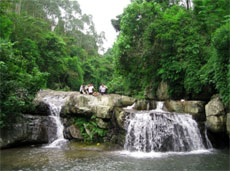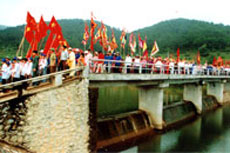Located at Nghia Phuong Commune, Luc Nam District, the northern province of Bac Giang; about 90km from Ha Noi, Mo Stream winds through a valley between Huyen Dinh and Yen Tu mountains creating natural swimming pools and waterfalls.
 Tourists flock to the site to enjoy the wonderful natural environment and visit a complex of temples worshipping the Mother of the Forest, Que My Nuong, belonging to Dao Mau (Holy Mother Goddess Religion).
Tourists flock to the site to enjoy the wonderful natural environment and visit a complex of temples worshipping the Mother of the Forest, Que My Nuong, belonging to Dao Mau (Holy Mother Goddess Religion).
The three temples that can be found along the stream consist of the Thuong (Upper), Trung (Middle) and Ha (Lower) and were built during the 10th century Le dynasty. Que My Nuong, a daughter of King Hung Dinh Vuong (1400 BC) is credited with creating the Mo Stream and waterfalls that feed the fields and developing irrigation works. The people respect her as Mother of the Forest and worship at the temples.
The legend says, one day, the princess wandered about enjoying the beautiful landscapes. She visited the commune and realised that local agriculture often faced droughts. She climbed to the mountain’s peak, pressed her hand on the stone, and from her finger prints, five waterfalls appeared leading water to the fields, saving the people’s crops. Since then, the stream has been known as the Mo (Fertile).
She discussed with the village chiefs and designed irrigation plans for the region. The Trung Temple still preserves the place where the princess and the elders sat. A large stone right in the middle of the temple’s yard is the centre of the site. Pilgrims visiting the temple often touch their hands to the stone as they believe that healthiness and happiness would come.
The region experiences floods between May and October which sometimes sweep away the bridge leading to the temple, but the water level has never reached to the temple’s yard. The temple at this time of year resembles an island and can only be visited by tourists via boat, says tour guide Do Bach Tra.
Ha Temple was built on large scale in typical religious architecture. It’s the place for pilgrims to burn incense and ask for holy permission to visit the other temples and pagodas in the site.
Thuong Temple is located at the highest point. Leaning on the mountain, the temple has its rear linked to a stone chamber built into the mountain.
A path beside Thuong Temple leads tourists to Giong Khe, with a panoramic view of the mountains and streams.
Due to geological tectonics, large stones of different shapes can be found. These stones are placed in tiers to make different levels of slopes within the stream bed, which result in various falls of different sizes. As a result, many natural bath tubs have been formed. Along both sides of the stream are luxuriant trees looking into the clear water.
 The Mo Stream Festival is held annually on the first day of the fourth month of the lunar calendar. Neighbouring villages and communes join the festival by contributing offerings to the locals and young women and men for the festival procession. They are divided into different processional teams wearing red, green, brown and yellow.
The Mo Stream Festival is held annually on the first day of the fourth month of the lunar calendar. Neighbouring villages and communes join the festival by contributing offerings to the locals and young women and men for the festival procession. They are divided into different processional teams wearing red, green, brown and yellow.
When the rites are finished, festival-goers join various festive activities such as archery, traditional martial arts, cock fighting, wrestling and swinging.
Hau dong (spiritual singing) is performed in the evenings at all temples to entertain and praise the gods.
Large numbers of pilgrims who attend the festival. Women often come to pray for happiness and health, and enjoy the hau dong performance. Young people enjoy the sightseeing of mountains and streams. Men sit down together and enjoy the local wine and tea.
Another must-see venue is the Tran Temple worshipping General Tran Hung Dao. The race tracks and holes for measuring soldiers are remains that prove that the Tran dynasty’s troops were stationed at the location to fight against Mongol invaders in the 13th century.
Before and after a battle, the soldiers jumped into the holes. Each hole could contain ten people. Through counting the holes, a commander could find out how many soldiers had been lost.